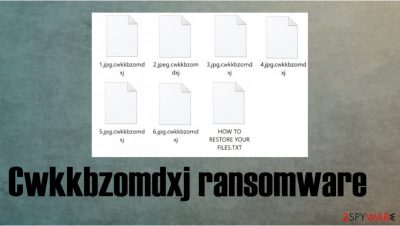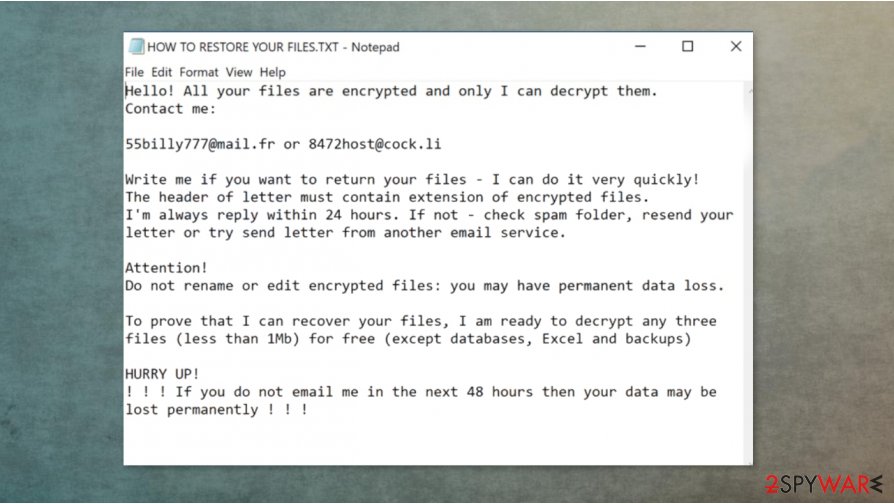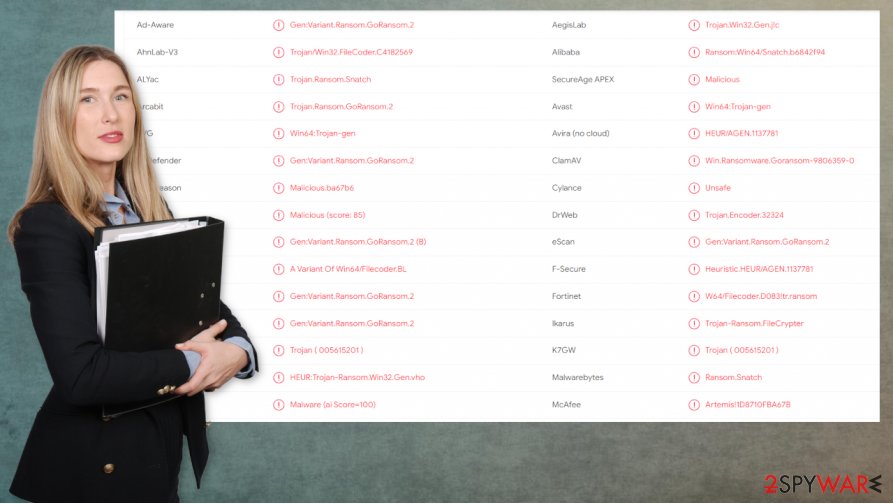Cwkkbzomdxj ransomware (Virus Removal Guide) - Recovery Instructions Included
Cwkkbzomdxj virus Removal Guide
What is Cwkkbzomdxj ransomware?
Cwkkbzomdxj ransomware – a file-locking virus that urges its victims to establish contact within 48 hours

Cwkkbzomdxj ransomware is a cryptovirus from the Snatch ransomware family. This computer virus encrypts files (non-system) on targeted devices, appoints a .cwkkbzomdxj extension to all of them, and creates ransom notes (HOW TO RESTORE YOUR FILES.TXT) demanding money for a promised decryption tool.
Ransomware from this lineage, such as Zybvqxefmh, Nsemad, Gcahvv, and others, use a military-grade AES[1] coding algorithm to encrypt all personal data (documents, pictures, archives, databases, etc.), making it inaccessible until a specific decryption key is used to unlock them.
Ransom notes are created to convey instructions from the cybercriminals to their victims on what to do to get their data back. Cwkkbzomdxj ransomware virus creators would like to be contacted via the two given emails (55billy777@mail.fr, 8472host@cock.li), where they would disclose further ransom details.
| name | Cwkkbzomdxj ransomware, .cwkkbzomdxj file virus |
|---|---|
| Type | Ransomware |
| Family | Snatch ransomware |
| Ransom note | HOW TO RESTORE YOUR FILES.TXT |
| appended file extension | .cwkkbzomdx |
| Criminal contact details | 55billy777@mail.fr, 8472host@cock.li |
| Virus removal | Entrust ransomware elimination to trustworthy anti-malware software |
| System health check | Run system clean-up and tune-up with powerful system repair tools like the FortectIntego app |
The ransom note of Cwkkbzomdxj ransomware isn't particularly informative. The assailants state that they encrypted all personal data and that only they can restore it. They provide contact details, and to prove that they possess the necessary tools, they offer free decryption of any three files (not exceeding 1Mb).
Also, the cybercriminals warn their victims not to rename or edit the encrypted files and urge to contact them within 48 hours of the attack, or the data might be permanently lost. The whole ransom note message from HOW TO RESTORE YOUR FILES.TXT reads:
Hello! All your files are encrypted and only I can decrypt them.
Contact me:55billy777@mail.fr or 8472host@cock.li
Write me if you want to return your files – I can do it very quickly!
The header of letter must contain extension of encrypted files.
I'm always reply within 24 hours. If not – check spam folder, resend your letter or try send letter from another email service.Attention!
Do not rename or edit encrypted files: you may have permanent data loss.To prove that I can recover your files, I am ready to decrypt any three files (less than 1Mb) for free (except databases, Excel and backups)
HURRY UP!
! ! ! If you do not email me in the next 48 hours then your data may be lost permanently ! ! !
Although paying the demanded ransom can seem like the easiest way out of this nightmare, it's actually the worse thing a cyberattack victim can do. There's absolutely no guarantee that the promised decryption tool will ever be delivered, but the ransom money could be used to attack more innocent everyday computer users.

The only right move is to remove Cwkkbzomdxj ransomware from all affected devices right away. Manual deletion is possible but might be too difficult for regular computer users, so we recommend untrusting this dirty work to trustworthy anti-malware software like SpyHunter 5Combo Cleaner or Malwarebytes.
Based on research from VirusTotal,[2] only 41 out of 71 anti-malware (AV) engines have detected the culprit of this article, once again showing the necessity of reliable AV software. Here are a few examples of .cwkkbzomdxj file virus detection names:
- Ransom.Snatch
- HEUR:Trojan-Ransom.Win32.Gen.vho
- Ransom:Win64/Snatch.A!MTB
- Heuristic.HEUR/AGEN.1137781
- Gen:Variant.Ransom.GoRansom.2
Due to the fact that most cryptoviruses mess up system settings, such as the system registry, experts[3] suggest using the FortectIntego app or any other powerful system repair tool, after Cwkkbzomdxj ransomware removal, to scan the entire computer system and restore any changes back to normal.

Evading infection through spam emails – one of the most common ransomware spreading techniques
Cybercriminals have many weapons at their disposal when it comes to ransomware distribution, but one of the most common ways used to infect victim computers is spam emails. These emails might contain one of two (or both) virus spreading techniques:
- mischievous hyperlinks that lead to malicious sites riddled with malware;
- infected attachments that contain virus payload files, camouflaged as important documents, invoices, etc.
There's a spam folder for a reason. All emails there must be deleted regularly. Some of them might bypass email providers' security screening and end up in your inbox. Be aware of emails urging you to open any link or download an attachment right away. All email attachments must be scanned with anti-malware apps before downloading them.
Directions for Cwkkbzomdxj ransomware removal and system repair
If your device got infected with Cwkkbzomdxj ransomware virus, you don't have to panic and give in to the cybercriminals' demands. There might be other data recovery options. As we've mentioned before, paying the ransom is the worse option for a cyberattack victim.
Since there's no decryption software available at the moment before you remove Cwkkbzomdxj ransomware, you should copy all encrypted files to offline storage, such as a USB drive or similar. Only then use dependable anti-malware software like SpyHunter 5Combo Cleaner or Malwarebytes to eliminate the infection. This will not recover encoded files, but infection gets treated.
Keeping in mind that file-locking viruses alter various system settings to help them thrive in the infected device, after Cwkkbzomdxj virus removal, you should consider using powerful system repair tools such as the FortectIntego app to undo these modifications.
Getting rid of Cwkkbzomdxj virus. Follow these steps
Manual removal using Safe Mode
Remoe infections in Safe Mode with Networking if it can't be done while Windows in normal mode
Important! →
Manual removal guide might be too complicated for regular computer users. It requires advanced IT knowledge to be performed correctly (if vital system files are removed or damaged, it might result in full Windows compromise), and it also might take hours to complete. Therefore, we highly advise using the automatic method provided above instead.
Step 1. Access Safe Mode with Networking
Manual malware removal should be best performed in the Safe Mode environment.
Windows 7 / Vista / XP
- Click Start > Shutdown > Restart > OK.
- When your computer becomes active, start pressing F8 button (if that does not work, try F2, F12, Del, etc. – it all depends on your motherboard model) multiple times until you see the Advanced Boot Options window.
- Select Safe Mode with Networking from the list.

Windows 10 / Windows 8
- Right-click on Start button and select Settings.

- Scroll down to pick Update & Security.

- On the left side of the window, pick Recovery.
- Now scroll down to find Advanced Startup section.
- Click Restart now.

- Select Troubleshoot.

- Go to Advanced options.

- Select Startup Settings.

- Press Restart.
- Now press 5 or click 5) Enable Safe Mode with Networking.

Step 2. Shut down suspicious processes
Windows Task Manager is a useful tool that shows all the processes running in the background. If malware is running a process, you need to shut it down:
- Press Ctrl + Shift + Esc on your keyboard to open Windows Task Manager.
- Click on More details.

- Scroll down to Background processes section, and look for anything suspicious.
- Right-click and select Open file location.

- Go back to the process, right-click and pick End Task.

- Delete the contents of the malicious folder.
Step 3. Check program Startup
- Press Ctrl + Shift + Esc on your keyboard to open Windows Task Manager.
- Go to Startup tab.
- Right-click on the suspicious program and pick Disable.

Step 4. Delete virus files
Malware-related files can be found in various places within your computer. Here are instructions that could help you find them:
- Type in Disk Cleanup in Windows search and press Enter.

- Select the drive you want to clean (C: is your main drive by default and is likely to be the one that has malicious files in).
- Scroll through the Files to delete list and select the following:
Temporary Internet Files
Downloads
Recycle Bin
Temporary files - Pick Clean up system files.

- You can also look for other malicious files hidden in the following folders (type these entries in Windows Search and press Enter):
%AppData%
%LocalAppData%
%ProgramData%
%WinDir%
After you are finished, reboot the PC in normal mode.
Remove Cwkkbzomdxj using System Restore
Computer virus infection might be removed with System Restore
-
Step 1: Reboot your computer to Safe Mode with Command Prompt
Windows 7 / Vista / XP- Click Start → Shutdown → Restart → OK.
- When your computer becomes active, start pressing F8 multiple times until you see the Advanced Boot Options window.
-
Select Command Prompt from the list

Windows 10 / Windows 8- Press the Power button at the Windows login screen. Now press and hold Shift, which is on your keyboard, and click Restart..
- Now select Troubleshoot → Advanced options → Startup Settings and finally press Restart.
-
Once your computer becomes active, select Enable Safe Mode with Command Prompt in Startup Settings window.

-
Step 2: Restore your system files and settings
-
Once the Command Prompt window shows up, enter cd restore and click Enter.

-
Now type rstrui.exe and press Enter again..

-
When a new window shows up, click Next and select your restore point that is prior the infiltration of Cwkkbzomdxj. After doing that, click Next.


-
Now click Yes to start system restore.

-
Once the Command Prompt window shows up, enter cd restore and click Enter.
Bonus: Recover your data
Guide which is presented above is supposed to help you remove Cwkkbzomdxj from your computer. To recover your encrypted files, we recommend using a detailed guide prepared by 2-spyware.com security experts.If your files are encrypted by Cwkkbzomdxj, you can use several methods to restore them:
File restore with the help of Data Recovery Pro
Data Recovery Pro might be able to restore .cwkkbzomdxj extension files.
- Download Data Recovery Pro;
- Follow the steps of Data Recovery Setup and install the program on your computer;
- Launch it and scan your computer for files encrypted by Cwkkbzomdxj ransomware;
- Restore them.
Using Windows Previous Version feature for data recovery
With Windows Previous Version function, users might be able to recover .cwkkbzomdxj extension files.
- Find an encrypted file you need to restore and right-click on it;
- Select “Properties” and go to “Previous versions” tab;
- Here, check each of available copies of the file in “Folder versions”. You should select the version you want to recover and click “Restore”.
Shadow Explorer might be useful for file recovery
This app could bring back old file versions from Shadow Volume Copies.
- Download Shadow Explorer (http://shadowexplorer.com/);
- Follow a Shadow Explorer Setup Wizard and install this application on your computer;
- Launch the program and go through the drop down menu on the top left corner to select the disk of your encrypted data. Check what folders are there;
- Right-click on the folder you want to restore and select “Export”. You can also select where you want it to be stored.
No decryption tool is currently available
Finally, you should always think about the protection of crypto-ransomwares. In order to protect your computer from Cwkkbzomdxj and other ransomwares, use a reputable anti-spyware, such as FortectIntego, SpyHunter 5Combo Cleaner or Malwarebytes
How to prevent from getting ransomware
Access your website securely from any location
When you work on the domain, site, blog, or different project that requires constant management, content creation, or coding, you may need to connect to the server and content management service more often. The best solution for creating a tighter network could be a dedicated/fixed IP address.
If you make your IP address static and set to your device, you can connect to the CMS from any location and do not create any additional issues for the server or network manager that needs to monitor connections and activities. VPN software providers like Private Internet Access can help you with such settings and offer the option to control the online reputation and manage projects easily from any part of the world.
Recover files after data-affecting malware attacks
While much of the data can be accidentally deleted due to various reasons, malware is one of the main culprits that can cause loss of pictures, documents, videos, and other important files. More serious malware infections lead to significant data loss when your documents, system files, and images get encrypted. In particular, ransomware is is a type of malware that focuses on such functions, so your files become useless without an ability to access them.
Even though there is little to no possibility to recover after file-locking threats, some applications have features for data recovery in the system. In some cases, Data Recovery Pro can also help to recover at least some portion of your data after data-locking virus infection or general cyber infection.
- ^ Advanced Encryption Standard. Wikipedia. The free encyclopedia.
- ^ Virustotal. Virustotal. Suspicious file analysis.
- ^ Virusler. Virusler. Spyware news and security.





















